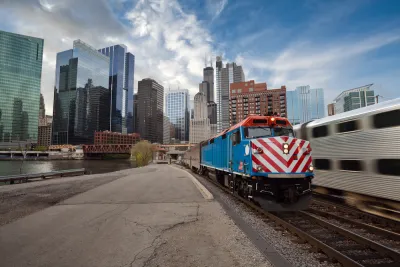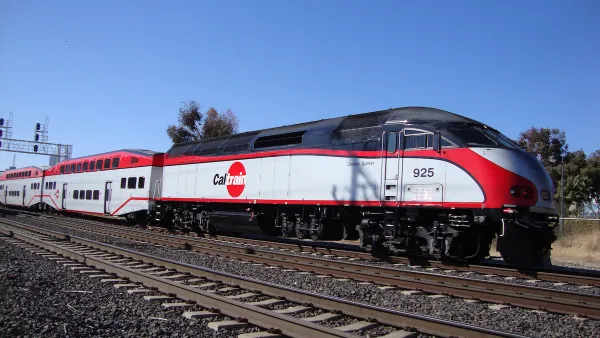Rather than building costly overhead electrification infrastructure to convert a Chicago-area commuter rail line from polluting diesel power to emission-free electricity, the Metra Board of Directors chose a far less expensive and quicker route.

“The Metra Board of Directors today approved a first-of-its-kind plan to convert up to six of Metra’s oldest diesel locomotives to zero-emission battery power,” states an August 17 press release (source article) from Metra, the nation's largest commuter rail system (by ridership based on the last quarter of 2019) outside of the New York metropolitan area. [Italics added below].
“This procurement puts Metra on the cutting edge of battery-powered technology and demonstrates our commitment to innovation and cleaner energy,” said Metra CEO/Executive Director Jim Derwinski. “If these locomotives prove themselves, they could play a significant role in our fleet and in our future, and the concept could serve as a template for other railroads to follow.”
Long Island Failure
“If” is most appropriate. The Long Island Rail Road (LIRR) pursued a similar pilot program, although not for diesel-powered locomotives but for retrofitting existing electric multiple unit trains, launched in April last year on its Oyster Bay Branch.
Alfonso Castillo, Newsday's transit reporter, listed three takeaways from the LIRR pilot in his article [subscription only; also see Trains, July 27] published August 6.
- The LIRR has decided not to go ahead with the next phase in its tests of “battery electric multiple units,” which would have allowed trains to operate on third-rail power, where available, then switch to battery power where it's not.
- An $860,000 feasibility study with train manufacturer Alstom raised several concerns, including over the price of retrofitting train cars with batteries — $26 million per pair — and over the need to remove seats from cars to make space for the technology.
- LIRR officials said they are not giving up on the technology, and could incorporate it into the design of its next generation of train cars, the M9A, which remains several years away. [I.e., rather than retrofitting existing cars, it would consider purchasing battery-equipped EMU cars].
Back to Chicago: the pilot will be applied to one of Metra's 11 commuter lines:
Metra plans to test the battery-powered locomotives, which will have an estimated range of about 150 miles, on the Rock Island Line. Charging stations, which will be designed after the locomotives are designed, will be placed in the main yard and at an outlying point. The duration of a full and partial recharge of the batteries won’t be known until then.
In Operation in Germany
Bombardier Transportation, based in Berlin, unveiled its Talent 3 Battery Train in September 2018 at Bombardier’s Hennigsdorf site in Germany, reported Railway Technology on February 25, 2020.
Talent 3 is fitted with MITRAC lithium-ion batteries. The batteries allow the trains to operate on more than 30% of the non-electrified lines in Germany.
The batteries can be charged by power from the overhead line while driving on electrified sections. In addition, a provision is available to charge them at stations and via recovered braking energy. Trains operating on non-electrified lines are powered by batteries mounted on the roof.
The Talent 3 BEMU has been in operation since January 24, 2022, according to Technische Universität Berlin.
A February post on Railvolution, a European on-line rail technology magazine, describes the operation of the Talent 3 BEMU on the Seenlandbahn, a railway line in Bavaria, and includes history on what we may mistakenly think is a new technology.
Battery train technology is not new in principle. Battery trains were already running in Germany in large numbers a century ago and the then Deutsche Bundesbahn also had hundreds of battery trains in its fleet
Another Alternative Electrified Train Debuts
Not to be forgotten in the discussion of electrifying trains without taking years to construct costly infrastructure is another important electrification technology—fuel cells. A press release from France-based Alstom, which acquired Bombardier Transportation in January 2021, announced the operation of the world's first fuel cell-powered train:
24 August 2022 – Alstom, global leader in smart and sustainable mobility, is proud to announce that the world’s first hydrogen train, the Coradia iLint, reached another historical milestone today in Bremervörde, Lower Saxony, Germany. It is now used on the world premiere 100% hydrogen train route, in passenger operation.
This regional train only emits steam and condensed water while operating with a low level of noise.
The Associated Press and CNN reported on the new zero-emission train fleet. “The trains, five of which which debut Wednesday, will gradually replace the 15 diesel trains that currently run on the route, with all 14 running exclusively by the end of the year. Just 1 kilo of hydrogen fuel can do the same as around 4.5 kilos of diesel,” wrote Julia Buckley for CNN.
“Emission free mobility is one of the most important goals for ensuring a sustainable future,” said Henri Poupart-Lafarge, Alstom's CEO, in a statement.
More on Metra in Planetizen:
- Moving Forward with Metra's Equity-Guided Transit System Plans, September 23, 2020
- Metra North Central Service Line Riders Push for More Service, June 12, 2020
More on fuel cell-powered trains: see the three posts under "Related" directly below this post!
Hat tip to Sierra Club's Clean Transportation for All Campaign.
FULL STORY: Metra to create battery-powered locomotives

National Parks Layoffs Will Cause Communities to Lose Billions
Thousands of essential park workers were laid off this week, just before the busy spring break season.

Retro-silient?: America’s First “Eco-burb,” The Woodlands Turns 50
A master-planned community north of Houston offers lessons on green infrastructure and resilient design, but falls short of its founder’s lofty affordability and walkability goals.

Delivering for America Plan Will Downgrade Mail Service in at Least 49.5 Percent of Zip Codes
Republican and Democrat lawmakers criticize the plan for its disproportionate negative impact on rural communities.

Test News Post 1
This is a summary

Test News Headline 46
Test for the image on the front page.

Balancing Bombs and Butterflies: How the National Guard Protects a Rare Species
The National Guard at Fort Indiantown Gap uses GIS technology and land management strategies to balance military training with conservation efforts, ensuring the survival of the rare eastern regal fritillary butterfly.
Urban Design for Planners 1: Software Tools
This six-course series explores essential urban design concepts using open source software and equips planners with the tools they need to participate fully in the urban design process.
Planning for Universal Design
Learn the tools for implementing Universal Design in planning regulations.
EMC Planning Group, Inc.
Planetizen
Planetizen
Mpact (formerly Rail~Volution)
Great Falls Development Authority, Inc.
HUDs Office of Policy Development and Research
NYU Wagner Graduate School of Public Service



























